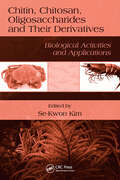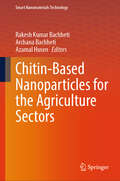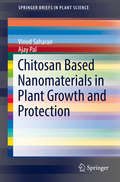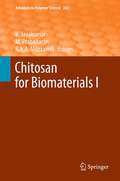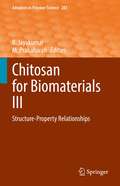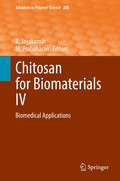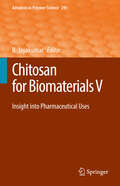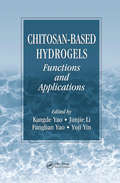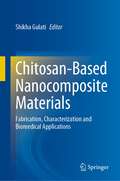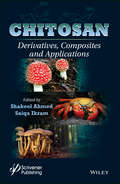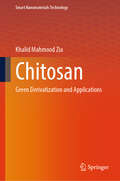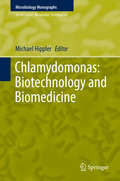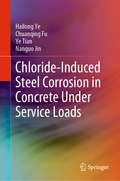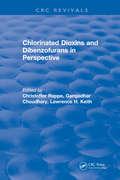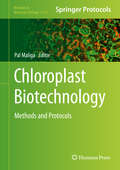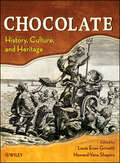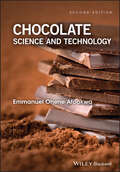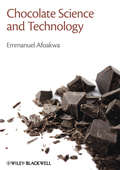- Table View
- List View
Chitin, Chitosan, Oligosaccharides and Their Derivatives: Biological Activities and Applications
by Se-Kwon KimBiopolymers found in marine animals and plants offer tremendous, largely untapped pharmaceutical potential. Research shows that these biopolymers can be used to combat various infectious as well as inflammatory, oxidative, and carcinogenic factors. Chitin, Chitosan, Oligosaccharides and Their Derivatives: Biological Activities and Applications cove
Chitin- and Chitosan-Based Biocomposites for Food Packaging Applications
by Sabu Thomas Jissy Jacob Sravanthi LoganathanChitin is one of the most important biopolymers, synthesized by an enormous number of living organisms and is a promising bioactive polymer for food packaging applications due to its functional properties. This book focuses on composition, properties, characterization, and theoretical approach of chitin and chitosan bio-composites. It describes the most recent studies concerning chitin and chitosan-based films and gives an overview about future trends regarding the industrial applications of chitin and chitosan for food packaging purposes. This book is especially useful for researchers in the fields of bionanocomposites, especially those with an interest in packaging applications.
Chitin-Based Nanoparticles for the Agriculture Sectors (Smart Nanomaterials Technology)
by Azamal Husen Rakesh Kumar Bachheti Archana BachhetiThis book provides an overview of chitin-based nanoparticles, including their properties, synthesis methods, and characterization techniques. It will also discuss the potential uses of chitin-based nanoparticles in agriculture, such as in crop protection, nutrient delivery, and soil improvement as well as potential areas for future research and development. Overall, the book would present a comprehensive and accessible resource for researchers, agricultural workers, policymakers, and other stakeholders who are interested in learning about the potential applications and benefits of chitin-based nanoparticles in agriculture.
Chitooligosaccharides: Prevention and Control of Diseases
by Se-Kwon KimThis book outlines the production of chitooligossacharides and their derivatives and discusses their main biological activities, biomedical applications and their role in disease prevention. Chitooligosaccharides are products of chitosan or chitin degradation, prepared by enzymatic or chemical hydrolysis of chitosan, and they consist mainly of N-acetyl glucosamine and glucosamine bonded with a glycosidic bond. Compared to chitin and chitosan, chitooligossacharides offer advantages for large-scale and commercial applications due to their solubility in water and lower molecular weight.Written by leading experts, this book is divided into four parts. The first part provides a general introduction to chitooligossacharides. The second part focuses on the bioproduction of chitooligossacharides through enzymatic synthesis and also covers physical and chemical methods of synthesis. The third part explores the major biological activities of chitooligosaccharides, including antioxidant, antimicrobial, anti-allergic, anti-inflammatory, anti-cancer and neuroprotective activities, and discusses the disease preventing mechanisms of chitooligosaccharides. In this section, readers will also find about the latest in vivo studies which support the use of chitooligosaccharides in the prevention and control of disease. The final part highlights important biomedical applications of chitooligosaccharides, including in tissue engineering, drug delivery and wound healing applications. It also includes the volume editor’s perspective on the health and safety risks of chitooligosaccharides.Given its scope, this book is useful not only for researches in the field but also for students interested in biomaterials, pharmaceuticals, marine biotechnology, nutraceuticals and food science.
Chitosan Based Nanomaterials in Plant Growth and Protection (SpringerBriefs in Plant Science)
by Vinod Saharan Ajay PalThis brief describes various methods of chitosan nano-materials synthesis, with detailed discussion of various factors effecting its synthesis process, stability and physicochemical properties. Chitosan is naturally occurring biopolymer derived from chitin. Due to the unique biological properties of chitosan nano-materials such as antimicrobial, plant growth inducer, plant defense modulator, chitosan has gained attention in fields of plant sciences. Book further extended the details of different types of chitosan nano-materials specially for plant applications along with its future prospects in plant protection and growth. Bioactivities of chitosan nano-materials and its mechanism have also been covered. This book aims to widening the understanding of the synthesis, characterization and use of chitosan based nano-materials in plant system.
Chitosan Nanocomposites: Bionanomechanical Applications (Biological and Medical Physics, Biomedical Engineering)
by Sarat Kumar Swain Anuradha BiswalThe book presents chitosan and chitosan-based nanocomposites and their extensive applications in medical science. Utilization of chitosan nanostructured composites in different biomedical applications is highlighted. The book is suitable to be used as reference/textbook for studying the biological aspects of chitosan hybrid materials and their efficacy in different therapeutic applications. The important features of the book are summarized as follows:Chitosan as an overviewKey biological aspects of chitosan-based nanocompositesSynthetic techniques for fabrication of chitosan nanocomposites for biomedical applicationsDesigning of chitosan-based smart materials for release of therapeuticsFabrication of nanostructured chitosan-based devices for diagnosis and sensing applicationsChitosan nanocomposites for regenerative applicationsMedicinal and therapeutic efficacy of chitosan-based hybrid materials.
Chitosan for Biomaterials I (Advances in Polymer Science #243)
by Riccardo A. Muzzarelli M. Prabaharan R. JayakumarPolymeric Nanoparticles of Chitosan Derivatives as DNA and siRNA Carriers, by Y. K. Kim, H. L. Jiang, Y. J. Choi, I. K. Park, M. H. Cho and C. S. Cho.- Chitosan and Its Derivatives for Drug Delivery Perspective, by T. A. Sonia and C. P. Sharma.- Chitosan-based Nanoparticles in Cancer Therapy, by V.-K. Lakshmanan, K. S. Snima, J. D. Bumgardner, S. V. Nair, and R. Jayakumar.- Chitosan and Thiolated Chitosan, by F. Sarti and A. Bernkop-Schnürch.- Chitosan-Based Particulate Systems for Non-Invasive Vaccine Delivery, by S. Şenel.- Multifunctional Chitosan Nanoparticles for Tumor Imaging and Therapy, by J. Y. Yhee, Heebeom Koo, Dong Eun Lee, Kuiwon Choi, Ick Chan Kwon and Kwangmeyung Kim.- Chitosan-Coated Iron Oxide Nanoparticles for Molecular Imaging and Drug Delivery, by H. Arami, Z. Stephen, O. Veiseh and M. Zhang.- Chitosan: Its Applications in Drug-Eluting Devices, by Mei -Chin Chen, Fwu -Long Mi, Zi -Xian Liao and Hsing -Wen Sung.-
Chitosan for Biomaterials II (Advances in Polymer Science #244)
by Rangasamy Jayakumar Riccardo A. Muzzarelli M. PrabaharanPolymeric Bionanocomposites as Promising Materials for Controlled Drug, by M. Prabaharan, R. Jayakumar; Chitosan and Chitosan Derivatives in Drug Delivery and Tissue Engineering, by R. Riva, H. Ragelle, A. des Rieux, N. Duhem, C. Jérôme, and V. Préat; Chitosan: A Promising Biomaterial for Tissue Engineering Scaffolds, by P. K. Dutta, K. Rinki and J. Dutta; Chitosan-Based Biomaterials for Tissue Repair and Regeneration, by X. Liu, L. Ma, Z. Mao and C. Gao; Use of Chitosan as a Bioactive Implant Coating for Bone-Implant Applications, by M. R. Leedy, H. J. Martin, P. A. Norowski, J. A. Jennings, W. O. Haggard, and J.D. Bumgardner; New Techniques for Optimization of Surface Area and Porosity in Nanochitins and Nanochitosans, by R. A. A. Muzzarelli; Production, Properties and Applications of Fungal Cell Wall Polysaccharides: Chitosan and Glucan, by N. New, T. Furuike, and H. Tamura;
Chitosan for Biomaterials III: Structure-Property Relationships (Advances in Polymer Science #287)
by M. Prabaharan R. JayakumarThis volume deals with chemical modification, structure-property relationship, biological interaction and biomedical applications of chitosan and its chemically modified derivatives. The chapters of this volume provide an overview of the structural comparison of chitosan with other sugar-based biopolymers, a different type of strategy used in chemical modification of chitosan to interact with metal ions and to enhance antimicrobial activity. The chapters further discuss the development of functionalized chitosan hydrogels, films, scaffolds and composites that have the potential to be used in food packaging, enhancing saltiness, biosensors and wound dressing. In addition the fabrication and biological properties of chitosan and its derivatives-based nanofibers are presented. Another important aspect covered in this volume is that of the interaction of chitosan with blood, platelet-rich plasma and stem cells. Finally, this volume presents the current challenges in the development of biomedical products based on chitosan and its derivatives. The volume will be of interest to chemists, material science, biological science and biomaterial scientists can able to understand structure-property relationship, biological interaction and biomedical applications of chitosan and its derivatives.
Chitosan for Biomaterials IV: Biomedical Applications (Advances in Polymer Science #288)
by M. Prabaharan R. JayakumarThis volume presents the recent developments on the biomedical applications of chitosan and its derivatives. Chitosan exhibits unique properties such as non-toxicity, biodegradability and biocompatibility. Since its chemical structure and properties can be easily modified, it can be an ideal candidate as a biomaterial. Consequently, chitosan and its derivatives are being developed in different forms such as nanoparticles, micelles, nanofibers, hydrogels, films and 3D porous materials for various biomedical applications, ranging from drug and gene delivery to tissue engineering and regenerative medicine. The chapters of this volume focus on the potential use of chitosan and its derivatives as a hemostatic agent, tissue sealants, tissue engineering scaffolds, delivery carriers for bioactive molecules in bone tissue engineering and wound dressings. Some chapter’s deal with recent advancements of chitosan-based biomaterials as a drug, gene and transdermal drug delivery carrier. In addition, the volume focusses on the prospects of chitosan-based systems for the treatment of cancer, eye and other infectious diseases. The volume will be of interest to material scientists, chemists and biotechnologists by providing a better understanding of the physicochemical and biological characteristics of chitosan and its derivatives to develop more appropriate and innovative chitosan-based materials modified for unlimited practical applications in biomedical fields.
Chitosan for Biomaterials V: Insight into Pharmaceutical Uses (Advances in Polymer Science #295)
by R. JayakumarThis volume offers an overview of Chitosan's role in facilitating peptide and biomolecule delivery, microbial resistance in wound care, tissue engineering, hemostasis, and drug delivery. It further delves into the challenges and potential applications of chitosan and its chemically modified derivatives within the pharmaceutical industry, with a particular focus on ocular and oral drug delivery, as well as targeted drug delivery systems. Moreover, this volume sheds light on the prominent use of chitosan and its derivatives, whether in their original forms or as membranes, beads, scaffolds, or films, within the domains of tissue engineering, wound healing, and hemostasis. Collectively, this comprehensive exploration aims to enhance our understanding of recent advancements and innovative chitosan-based systems in pharmaceutical and nutraceutical applications, thereby illuminating the myriad possibilities that lie ahead.
Chitosan-Based Hydrogels: Functions and Applications
by Junjie Li Kangde Yao Fanglian Yao Yuji YinDue to their unique properties, chitosan-based materials have emerged as useful resources in a variety of medicines, drug controlled-release carriers, tissue engineering scaffolds, and immobilized enzymes. But many of these materials have yet to reach the commercial market. Therefore, more work must be completed to fill the gap between research and
Chitosan-Based Nanocomposite Materials: Fabrication, Characterization and Biomedical Applications
by Shikha GulatiThis book highlights the state-of-the-art research and discovery in the use of chitosan-based nanocomposites in biomedical applications, including the scope to which these novel materials have been incorporated by the community. It provides an exceptional insight into the strategies for the synthesis and chemical modifications of chitosan, characterization techniques, their use as anticancer agents, antimicrobial, antiviral, and antifungal agents, their role in the biomedical field, and applications in drug delivery, gene therapy, dentistry, orthopedics, etc. This book will also emphasize the challenges with previous signs of progress and way for further research, details relating to the current pioneering technology, and future perspectives with a multidisciplinary approach. Furthermore, it presents up-to-date information on the economics, toxicity, and regulations related to these novel materials.
Chitosan: Derivatives, Composites and Applications
by Saiqa Ikram Shakeel AhmedThis book delves deeply in to the preparation, characterization and multiple applications of chitin and chitosan. The 17 chapters written by leading experts is an excellent reference source and state-of-the-art review for researchers and scientists using chitosan or biopolymers in their respective areas. This book is divided into following sections:• Production and derivatives of chitosan• Chitosan in the textile and food industries• Chitosan in biomedical applications• Chitosan in agriculture and water treatment The book is practical as readers will be able to see descriptions of chitosan production methods as well as techniques that can be used to estimate and modify their physical and chemical properties. It provides a full description not only of the traditional and recent developments in the applications of chitosan in the fields of biotechnology, environmental studies, food, medicine, water treatments, drug delivery, but it includes all of the therapeutically usages as well.
Chitosan: Green Derivatization and Applications (Smart Nanomaterials Technology)
by Khalid Mahmood ZiaThis book highlights the latest advances and novel technologies for the preparation, functionalization, and green derivitization of chitosan nanoparticles. The modification, biomedical applications, regulatory status and clinical trials of chitosan and its derivatives are also presented. Effective and innovative strategies enable increased influence on final characteristics, stability, and sustainability of chitosan nanoparticles. The book begins by examining chitosan nanoparticles, preparation and functionalization of the chitosan derivatives. This is followed by in-depth coverage of green derivatization and modification of chitosan nanoparticles (CSNPs), regulatory status and clinical trials of chitosan and derivatives, characterization techniques for the chitosan nanoparticles and derivatives along with key applications of modified CSNPs in water, food and agriculture industries, and biomedical applications including chemotherapy. The final chapters provide detailed discussions on chitosan as tools to combat COVID-19 and recent challenges and future prospectus of green derivatized chitosan nanoparticles.
Chitosan: Properties and Applications in Bioengineering (Synthesis Lectures on Engineering, Science, and Technology)
by Diana Marcela Escobar SierraChitosan: Properties and Applications in Bioengineering presents a review of chitosan, including information regarding its structure, main properties, available sources, extraction, and processing techniques. It presents the different applications of chitosan as a biomaterial in fields such as medicine and the agricultural, cosmetology, pharmaceutical, and food industries to have readers obtain a more technical vision of the current use of this biopolymer. The book has been researched and written based on the data collected through several years of work in the Biomaterials Research Group, part of the University of Antioquia Bioengineering Program. This concise guide will be valuable for researchers and students in biomaterials, bioengineering, the basic sciences, chemical engineering, and biomedical engineering.
Chlamydomonas: Biotechnology and Biomedicine (Microbiology Monographs #31)
by Michael HipplerThis Microbiology Monographs volume covers the current and most recent advances in genomics and genetics, biochemistry, physiology, and molecular biology of C. reinhardtii. Expert international scientists contribute with reviews on the genome, post-genomic techniques, the genetic toolbox development as well as new insights in regulation of photosynthesis and acclimation strategies towards environmental stresses and other structural and genetic aspects, including applicable aspects in biotechnology and biomedicine. Advancement in Chlamydomonas biology allowed new understandings in biotechnological and biomedical related aspects.
Chloride-Induced Steel Corrosion in Concrete Under Service Loads
by Ye Tian Hailong Ye Chuanqing Fu Nanguo JinThis book summarizes the latest advances in understanding chloride ingress and steel corrosion in concrete under service loads. Unlike the existing literature, it focuses specifically on the effect of service loads on chloride-induced durability issues in reinforced concrete structures. It discusses how service loads affect the moisture and chloride penetration rate, corrosion kinetics and rust distribution, as well as the structural performance of concrete components (e.g. beams and columns) in a systematic and hierarchical way. Given its scope, the book is chiefly intended for researchers and industry practitioners in structural engineering, particularly those whose work involves the durability design of concrete structures.
Chlorinated Dioxins and Dibenzofurans in Perspective
by Christoffer RappeThis volume was developed from the proceedings of a symposium held in Miami Beach, at the 189th National Meeting of the American Chemical Society.It is the result of the combined efforts of many experts whose efforts have advanced our knowledge of the production, analysis, distribution, effects and control of chlorinated dioxins, dibenzofurans and related compounds.This is the third in a series of publications originating from current technology presented at national meetings of the American Chemical Society. Using this forum as a catalyst, researchers from all over the world came together to present and discuss their data and plan future work in this rapidly developing and sometimes highly emotional technical area.
Chlorinated Solvent Source Zone Remediation (SERDP ESTCP Environmental Remediation Technology #7)
by C. Herb Ward Hans F. Stroo Bernard H. Kueper Catherine M. VogelThe purpose of this book is to help engineers and scientists better understand dense nonaqueous phase liquid (DNAPL) contamination of groundwater and the methods and technology used for characterization and remediation. Remediation of DNAPL source zones is very difficult and controversial and must be based on state-of-the-art knowledge of the behavior (transport and fate) of nonaqueous phase liquids in the subsurface and site specific geology, chemistry and hydrology. This volume is focused on the characterization and remediation of nonaqueous phase chlorinated solvents and it is hoped that mid-level engineers and scientists will find this book helpful in understanding the current state-of-practice of DNAPL source zone management and remediation.
Chlorophyll Fluorescence: Understanding Crop Performance — Basics and Applications
by Mohamed H. Kalaji Vasilij N. Goltsev Krystyna Żuk-Gołaszewska Marek Zivcak Marian BresticChlorophyll a fluorescence is a tool for evaluating plant responses to stress conditions. Fluorescence can be used in plant phenotyping and breeding programs to monitor biotic and abiotic stresses including mineral deficiencies, soil salinity, and pathogenic diseases. Chlorophyll Fluorescence: Understanding Crop Performance — Basics and Applications reviews a diversity of instruments available for recording and analyzing different types of light signals from plants and addresses the use of chlorophyll a fluorescence in research on plants and other photosynthesizing organisms, such as algae and cyanobacteria. This book characterizes the phenomenon of chlorophyll a fluorescence, describes the methods for its measurement, and demonstrates — using selected examples — the applicability of these methods to research the response of the photosynthetic apparatus and plant tolerance to unfavorable environmental conditions. In addition, chapters cover a general background on photosynthesis, analysis of delayed fluorescence, and the pulse amplitude modulated (PAM) technique. The book is addressed to a wide range of professionals in photosynthesis research and scientists from other areas of plant sciences.
Chloroplast Biotechnology: Methods and Protocols (Methods in Molecular Biology #1132)
by Pal MaligaIn Chloroplast Biotechnology: Methods and Protocols, expert researchers in the field detail many of the methods which are now commonly used in chloroplast molecular biology. Chapters focus on essential background information, applications in tobacco, and protocols for plastid transformation in crops, and Chlamydomonas and Bryophytes. Written in the highly successful Methods in Molecular Biology series format, chapters include introductions to their respective topics, lists of the necessary materials and reagents, step-by-step, readily reproducible laboratory protocols, and key tips on troubleshooting and avoidance of known pitfalls. Authoritative and practical, Chloroplast Biotechnology: Methods and Protocols seeks to aid scientists who study chloroplast molecular biology as well as those interested in applications in agriculture, industrial biotechnology, and healthcare. --
Chocolate
by Louis E. Grivetti Howard-Yana ShapiroInternational Association of Culinary Professionals (IACP) 2010 Award Finalists in the Culinary History category.Chocolate. We all love it, but how much do we really know about it? In addition to pleasing palates since ancient times, chocolate has played an integral role in culture, society, religion, medicine, and economic development across the Americas, Africa, Asia, and Europe.In 1998, the Chocolate History Group was formed by the University of California, Davis, and Mars, Incorporated to document the fascinating story and history of chocolate. This book features fifty-seven essays representing research activities and contributions from more than 100 members of the group. These contributors draw from their backgrounds in such diverse fields as anthropology, archaeology, biochemistry, culinary arts, gender studies, engineering, history, linguistics, nutrition, and paleography. The result is an unparalleled, scholarly examination of chocolate, beginning with ancient pre-Columbian civilizations and ending with twenty-first-century reports.Here is a sampling of some of the fascinating topics explored inside the book:Ancient gods and Christian celebrations: chocolate and religionChocolate and the Boston smallpox epidemic of 1764Chocolate pots: reflections of cultures, values, and timesPirates, prizes, and profits: cocoa and early American east coast tradeBlood, conflict, and faith: chocolate in the southeast and southwest borderlands of North AmericaChocolate in France: evolution of a luxury productDevelopment of concept maps and the chocolate research portalNot only does this book offer careful documentation, it also features new and previously unpublished information and interpretations of chocolate history. Moreover, it offers a wealth of unusual and interesting facts and folklore about one of the world's favorite foods.
Chocolate Science and Technology
by Emmanuel Ohene AfoakwaThis second edition provides information on recent advances in the science and technology of chocolate manufacture and the entire international cocoa industry. It provides detailed review on a wide range of topics including cocoa production, cocoa and chocolate manufacturing operations, sensory perception of chocolate quality, flavour release and perception, sugar replacement and alternative sweetening solutions in chocolate production, industrial manufacture of sugar-free chocolates as well as the nutrition and health benefits of cocoa and chocolate consumption. The topics cover modern cocoa cultivation and production practices with special attention on cocoa bean composition, genotypic variations in the bean, post-harvest pre-treatments, fermentation and drying processes, and the biochemical basis of these operations. The scientific principles behind industrial chocolate manufacture are outlined with detailed explanations of the various stages of chocolate manufacturing including mixing, refining, conching and tempering. Other topics covered include the chemistry of flavour formation and development during cocoa processing and chocolate manufacture; volatile flavour compounds and their characteristics and identification; sensory descriptions and character; and flavour release and perception in chocolate. The nutritional and health benefits of cocoa and chocolate consumption as well as the application of HACCP and other food safety management systems such as ISO 22,000 in the chocolate processing industry are also addressed. Additionally, detailed research on the influence of different raw materials and processing operations on the flavour and other quality characteristics of chocolates have been provided with scope for process optimization and improvement. The book is intended to be a desk reference for all those engaged in the business of making and using chocolate worldwide; confectionery and chocolate scientists in industry and academia; students and practising food scientists and technologists; nutritionists and other health professionals; and libraries of institutions where agriculture, food science and nutrition is studied and researched.
Chocolate Science and Technology
by Emmanuel Ohene AfoakwaThis book provides an overview of the science and technology of chocolate manufacture from cocoa production, through the manufacturing processes, to the sensory, nutrition and health aspects of chocolate consumption. It covers cocoa cultivation and production with special attention paid to cocoa bean composition, genotypic variations in the bean, post-harvest pre-treatments, fermentation and drying processes, and the biochemical basis of these operations. The scientific principles behind industrial chocolate manufacture are outlined with detailed explanations of the various stages of chocolate manufacturing including mixing, refining, conching and tempering. Other topics covered include the chemistry of flavour formation and development during cocoa processing and chocolate manufacture; volatile flavour compounds and their characteristics and identification; sensory descriptions and character; and flavour release and perception in chocolate. The nutritional and health benefits of cocoa and chocolate consumption are also addressed. There is a focus throughout on those factors that influence the flavour and quality characteristics of the finished chocolate and that provide scope for process optimization and improvement. The book is designed to be a desk reference for all those engaged in the business of making and using chocolate worldwide; confectionery and chocolate scientists in industry and academia; students and practising food scientists and technologists; nutritionists and other health professionals; and libraries of institutions where food science is studied and researched. an overview of the science behind chocolate manufacture covers the whole process from cocoa production, through manufacturing, to the nutrition and health aspects of chocolate consumption focuses on factors that influence chocolate flavour and quality, and that provide scope for process optimization and improvement.
